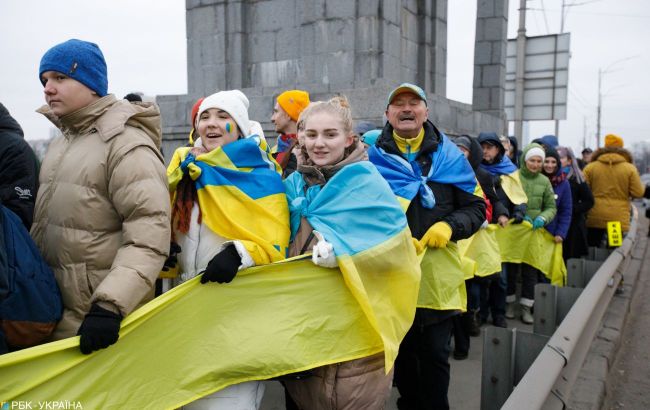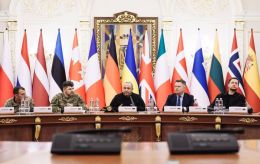Ukraine celebrates Unity Day: Symbol of national unification and solidarity
 Human Chain on Unity Day (Vitalii Nosach, RBC-Ukraine)
Human Chain on Unity Day (Vitalii Nosach, RBC-Ukraine)
The Ukrainian Unity Day is celebrated on January 22 in memory of the proclamation of the Act of Unification of the Ukrainian People's Republic (UPR) and the West-Ukrainian People's Republic (WUPR). On this historic day 105 years ago, Ukrainian lands were united in one state for the first time, and the main tradition of the holiday in the early 90s became the largest anti-Soviet action.
Sources used: Ukrainian Institute of National Memory, Wikipedia, and the Great Ukrainian Encyclopedia.
January 22 - Unity Day and anniversary of "first" independence
Today, Ukraine commemorates an important event in the history of the state. On January 22, 1919, a solemn meeting was held on St. Sophia Square, during which the UPR (Ukrainian People's Republic) and the WUPR (West-Ukrainian People's Republic) united.
This was confirmed by the Universal of the Ukrainian People's Republic on Unification (reunification). The document proclaimed:
"From now on into one merge torn away one from other portions of United Ukraine, the West-Ukrainian People's Republic (Galicia, Bukovina, Ugric Ruthenia) and the Dnieper Great Ukraine. The age-old dreams that the best sons of Ukraine lived and died for have come true. Today we have a single independent Ukrainian People's Republic."
It is noteworthy that the date of the proclamation of the Unification Act was not accidental. A year earlier, on January 22, 1918, the Central Rada proclaimed the independence of the UPR. On that day, the IV Universal was issued, which contained the following provisions:
- Proclamation of the independence of the Ukrainian People's Republic;
- Instructing the Council of People's Ministers to conclude peace with the Central Powers;
- Declaration of a defensive war with Bolshevik Russia;
- Declaration of the foundations of internal socio-economic construction and outlining measures to end the war with the Central Powers.
- Photo: Meeting on St. Sophia Square on January 22, 1919 (vue.gov.ua)
Photo: Meeting on St. Sophia Square on January 22, 1919 (vue.gov.ua)
Against the backdrop of the fall of the Russian and Austro-Hungarian empires, the Ukrainian lands that were part of them managed to reunite in 1919. Although the actual reunification was not completed at that time. The struggle against the "white" and "red" Russians continued, the governments and armies of the UPR and WUPR acted separately, and their geopolitical interests and goals differed.
In February 1919, the UPR governmental institutions were forced to leave Kyiv under the pressure of the Bolshevik army. Subsequently, most of the Western region of the UPR was occupied by Polish troops, Northern Bukovyna by Romanian troops, and Transcarpathia came under Czechoslovakian rule.
Nevertheless, the events of January 22, 1919, became a landmark in the history of Ukraine and for years inspired subsequent generations to fight for freedom and independence. After the proclamation of the Act of Unification, there could be no doubt about the integrity of the Ukrainian nation.
Unity of Ukraine. What it means
The holiday honors the Unity that our country sought more than 100 years ago and is fighting for now. Unity is inseparable from statehood, sovereignty, and independence.
In general, the term has several meanings. It is the unification of all the lands inhabited by a particular nation into one state. It is also the spiritual consolidation of all citizens of the state, and their cohesion, regardless of nationality. In addition, Unity means the territorial integrity of the country.
For many years, Russian propaganda has divided people into "Westerners" and "Easterners," and imposed the belief that "Ukraine was invented by the Bolsheviks."
The events of 1919 disprove all these myths, but Ukrainians are once again forced to defend unity in the fight against the Russian aggressor. Today, Unity means the de-occupation of all the territories seized by Russia, as well as reunification with Donetsk, Luhansk, and Crimea.
The Ukrainian Institute of National Memory (UINM) notes that the slogan of Unity Day is 2024: "Our unity is our weapon."
Unity implies not only the memory of the common past but also requires cohesive cooperation for the sake of the future, both on the battlefield and in the rear, the UINM publication says.
 Photo: Unity is a symbol of unification and cohesion of the nation (Vitalii Nosach, RBC-Ukraine)
Photo: Unity is a symbol of unification and cohesion of the nation (Vitalii Nosach, RBC-Ukraine)
Human chain as symbol of unity
A human chain became the main tradition of the holiday in the early 90s. On the eve of Unity Day, January 21, 1990, Ukrainians held the first and largest anti-Soviet rally of the time, called Ukrainska Khvylia (Ukrainian Wave - ed.).
The event was organized for over six months. Representatives of Ukrainian patriotic forces were inspired by the Baltic Way. This was an action carried out by residents of Lithuania, Latvia, and Estonia on August 23, 1989, the anniversary of the occupation and division of Europe after the signing of the Molotov-Ribbentrop Pact. Back then, people held hands and connected Vilnius, Riga, and Tallinn in a human chain to honor the memory of the victims of Soviet repression with a minute of silence.
The Ukrainian human chain was much larger. Ivano-Frankivsk was the starting point, as this city was the capital of the WUPR in 1919.
According to various estimates, from 500,000 to 5 million citizens lined up in a 700 km long chain from Frankivsk, through a large number of cities and towns, including Lviv, Rivne, Zhytomyr, to Kyiv.
The action also took place in Kharkiv, although people from different regions mostly came to the capital. Delegations from Donetsk, Kharkiv, Cherkasy, and other regions joined the chain in Kyiv.

Photo: participants of the 1990 human chain with a poster "Kharkiv and Donetsk are Ukrainian from time immemorial" (wikimedia.org)
The Ukrainska Khvylia demonstrated the nation's desire for independence and became a symbol of the unity of people from the eastern and western regions of the country. However, even at that time, Soviet propaganda was actively promoting the topic of alleged differences between the inhabitants of these parts of Ukraine.
The tradition of human chains began to be revived in the 2000s. A large-scale event was held on Unity Day in Kyiv in 2011, with more than 1,000 participants gathered on the Paton Bridge, and similar events took place in about 20 cities.
In 2014, during the Revolution of Dignity, the rally took place on the Paton Bridge despite the threat of dispersal by the Interior Ministry's special forces. On the same day, it became known about the first deaths among the Maidan protesters - on January 22, snipers shot Serhii Nihoyan and Mykhailo Zhyznevskyi.
Human chains on the Paton Bridge on Unity Day were held annually before the coronavirus pandemic. Currently, large-scale celebrations are banned due to the Russian invasion.

